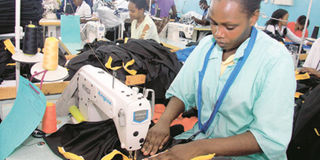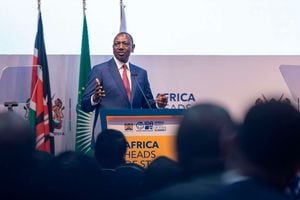Kenya sets up textile investors near power plants to cut costs

Workers at a Kenyan Export Processing Zone company that exports apparel to the US. Photo/ANTHONY KAMAU
What you need to know:
- Structural shift in the global apparel industry, which is looking to move factories from China and South-East Asia in response to rising labour costs.
- A survey by McKinsey and Company shows that East Africa—in particular, Ethiopia, Kenya, Tanzania, and Uganda have the potential to trade Sh300 billion in the garments and apparel industry by 2025.
- Kenya’s monthly wages for textile workers are Sh12,240 – Sh15,300 (US$120-150), less than a third of China’s average of Sh51,000 (US$500).
Kenya will set up investors near geothermal plants to cut the cost of electricity and offer subsidies in order to compete with her neighbours.
Mr Mohamed said on Thursday that they will set up investors at the shores of Lake Naivasha near the geothermal power plant to cut transmission charges to make Kenya attractive.
“We are going to set them up at Naivasha near the geothermal plant where power is much cheaper since it is at the source,” he said.
He was speaking when he met a trade delegation composed of investors from China, the US, Australia, the Netherlands and Bangladesh who will also be visiting Tanzania and Ethiopia.
Ethiopia is the leading investor destination of choice because of low labour costs with low minimum wage (Sh6,000). Furthermore, it is easier for foreigners to obtain work permit in the country.
Ethiopia also has low electricity prices and the government is building a separate grid for new industrial zones currently under development.
Following the extension of the African Growth and Development Act (AGOA) trade agreement with the USA for the next ten years, Kenya has been tipped to enjoy a boom as companies in the apparel industry target the East African economies to enjoy the duty free access to America.
A survey by McKinsey and Company shows that East Africa—in particular, Ethiopia, Kenya, Tanzania, and Uganda have the potential to trade Sh300 billion in the garments and apparel industry by 2025.
LABOUR COSTS
In 2013, these four countries’ apparel exports totalled only Sh34 billion.
Structural shift in the global apparel industry, which is looking to move factories from China and South-East Asia in response to rising labour costs.
Even though Kenyan workers demand twice as much in wages as Ethiopians they are still far below labour wages in East Asia making the East Africa's largest economy attractive.
Kenya’s monthly wages for textile workers are Sh12,240 – Sh15,300 (US$120-150), less than a third of China’s average of Sh51,000 (US$500).
The 15 member delegation has been organized by the VF Corporation and is in the country to engage the government and the private sector in order to understand the investment opportunities available in the manufacturing of textiles and apparels.
VF Corporation is a Worldwide Apparel and Footwear Company with more than 30 brands, 60,000 associates and US$12.3 billion in revenue.
Kenya expects to set up a major industrial park in the next two years at Naivasha which will serve as the main location for textile and apparel industries.
Mr Mohamed says Epic Designs and CNH Apparel have already committed to take up 300 square feet of space at Athi river.





